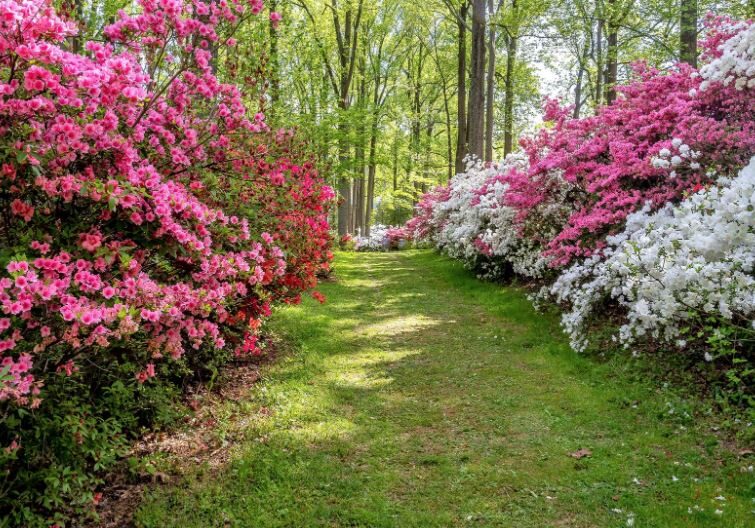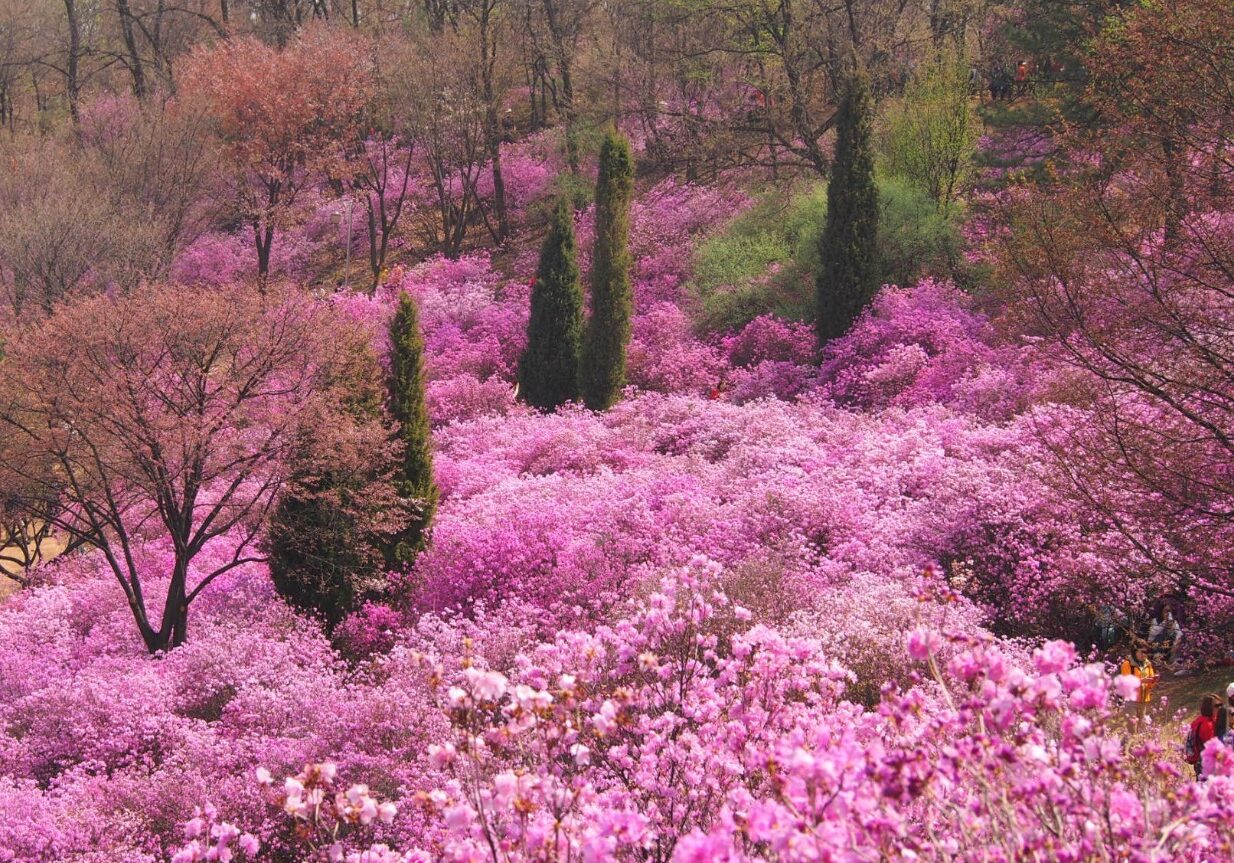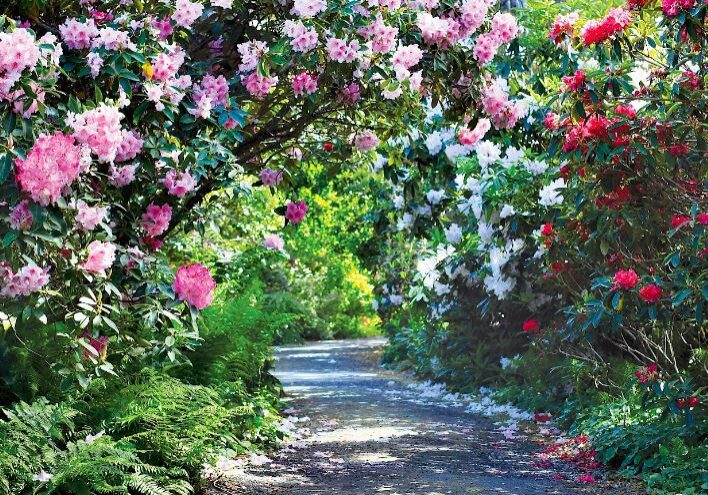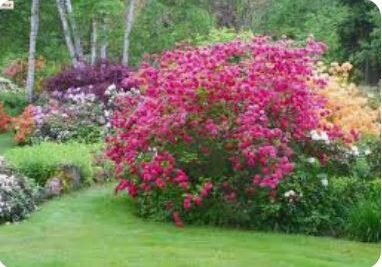
The Rhododendron Maze
We chose to combine these amazing flowering plants also known as Azaleas and create a maze out of it. Its hardy bush and beautiful flowers that bloom during the spring will give you a whole new experience of your ordinary hedge maze that's mostly just green throughout the spring and summer.

Origins
The earliest record of azaleas can be found in the "Shennong Bencao Jing" of the Han Dynasty, which lists "Sheep Azalea" as a poisonous plant. The history of azalea cultivation is at least more than a thousand years old. In the Tang Dynasty, ornamental azaleas appeared. At this time, azaleas were transplanted into gardens for cultivation. Bai Juyi (772-846), a famous Tang Dynasty poet, had a special liking for azaleas. He not only wrote many poems praising azaleas, but also transplanted and cultivated them himself.
The first transplant did not survive, and he wrote "What can I do about the deep roots of the rocks, so I can't transplant them to people's homes"; in 820, the transplant finally survived, and the poem said: "Today's flowers in Zhongzhou Island, last year's trees on the top of Mount Lu, I pity that the roots are damaged and newly planted, but I am glad that the flowers are still blooming as many as before." According to records, in the first year of the Zhenguan period of the Tang Dynasty (627), people had collected azalea varieties for cultivation. The most famous one is the azalea cultivated in the Helin Temple in Zhenjiang.
Song Dynasty
In the Song Dynasty, the cultivation of azaleas made new progress. The poet Wang Shipeng transplanted azaleas in his courtyard: "The Creator has given me a small garden, and this flower is more beautiful than a golden belt." The Southern Song Dynasty's "Xianchun Lin'an Chronicle" states: "Azaleas, this flower is in the Bodhi Temple at Qiantang Gate, and it is very prosperous. Su Dongpo wrote a poem about azaleas in Nanyi Hall. The foundation of the hall still exists today. There are many mountains where this flower is found." This shows that azaleas were already common in Hangzhou courtyards.


Ming Dynasty
In the Ming Dynasty, there was a further in-depth understanding of azaleas. For example, Zhiliang's "Shuichang Erfangji", "Dali Fuzhi" in 1563, Li Shizhen's "Compendium of Materia Medica" in 1587, and "Xu Xiake's Travel Notes" all have different degrees of records on the varieties, habits, distribution, application, breeding, and potted plants of azaleas. For example, the 1563 Dali Prefecture Records recorded 47 varieties of azaleas. Temples such as Chongsheng Temple and Gantong Temple in Dali had planted azaleas and cultivated five-color double-petal varieties. The Grass and Flower Catalogue recorded that "the azaleas from Sichuan are the best, called Sichuan azaleas, with more than ten layers of flowers and very red color; the ones from Siming (now Siming Mountain in Zhejiang) have two or three layers of flowers and are light in color."
qing Dynasty
In the Qing Dynasty, azaleas had already been shaped into bonsai. Zhu Guozhen's Yongchuang Xiaopin recorded that "Azaleas bloom in February and March when the cuckoos are singing. There are two types. One blooms first and then flowers (leaves first, flowers later), and the color is as red as blood; the other blooms first and then leaves (flowers first, leaves later), and the color is light, and many people say that it looks like a flying phoenix in a bowl." In addition, there is a complete set of experience in the cultivation of azaleas, and there are many records, such as Huajing, Guangqunfang Catalogue, Diannan Xinyu, and Penwanoulu. During the Jiaqing period (1796-1820), the Su Ling Lu listed azalea potted plants as the sixth of the "Eighteen Scholars". During the Daoguang period (1821-1850), the Tongqiao Yizhao mentioned "foreign tea, foreign azalea, mountain camellia, and mountain azalea", indicating that foreign azalea cultivation had been introduced into China at that time.


Because of the value of azalea in gardens, as early as the end of the 19th century, many Western countries sent people to Yunnan, China many times and collected a large number of azalea specimens and seedlings. Among them, British scholar Friess made seven or eight trips and discovered and collected 309 new azalea species, which were introduced to the Royal Botanic Garden Edinburgh in the UK.
Most of the hundreds of azalea species that the Royal Botanic Garden Edinburgh boasted about came from Yunnan. In 1919, Friess discovered the "Azalea Giant" tree azalea in Yunnan. A 25-meter-tall tree with a breast diameter of 87 centimeters and a tree age of 280 years was felled. A disc-shaped wood specimen was sawed and brought back to China and displayed in the British Museum in London. It was publicly exhibited and caused a sensation around the world. The tree rhododendron has been protected by the state. It is the pride of Yunnan and a national treasure of China.
In the 1920s and 1930s, rhododendron horticultural varieties from outside China began to enter coastal cities such as Shanghai, Wuxi, Guangzhou, Ningbo, Fuzhou, Xiamen, Qingdao, and Dandong in China. Gardening enthusiasts in Wuxi mail-order rhododendron seedlings from Japan's "Rose Garden", "Hundred Flowers Garden" and "Yokohama Uekishi Kaisha" every year. Shanghai Zhenru Huangyuan was a flower and tree farm established by Mr. Huang Yueyuan after the Xinhai Revolution. It covers an area of 7 hectares and has the largest collection of rhododendron varieties in China, with more than 30 species of hairy rhododendron, more than 500 species of eastern rhododendron, 700-800 species of summer rhododendron, and nearly 100 species of western rhododendron.
The Latin genus name in modern botany was established by Swedish botanist Linnaeus in 1753. It is a combination of the Greek words "Rhodon" (meaning rose color) and "Dendron" (meaning tree). The Chinese translation means red tree, which is what China commonly calls azalea.


The earliest hybridization of deciduous rhododendrons occurred in the early 19th century. The earliest recorded hybridization was an accidental hybridization between A. periclymenoides (the American subspecies of R. luteum) and R. ponticum (a common lilac plant found in many native forests and transplanted to Britain). The result of this unlikely cross, called ‘azaleadendron’, was not unique to the azalea rhododendron family, as the hybrid, Rhododendron hybridum, was added to the collection of the Royal Botanic Gardens, Edinburgh, in 1814.
ealiest hybridization
There are some early records that offer some interesting clues to how rhododendrons first arrived in Britain. Philip Miller worked at Chelsea Gardens in London from 1722 to 1770. During this time he wrote The Gardners’ Dictionary. The seventh edition of the book was published in 1759, and it included extensive discussions of both evergreen and deciduous rhododendrons. The eighth edition of 1768 specifically lists R. russatum, a mountain variety of China, and R. ferrugineum, a common native of the Alps and Pyrenees, also known as the Alpine rose. Philip Miller went on to write: "There are others that grow naturally in Eastern countries and America, but these two are the only ones I have seen in English gardens." That is, although some rhododendrons had been introduced to Britain, he had not seen them in person.


Later editions
In a later edition, he mentioned R. calendulaceum (A. calandulacea), an American rhododendron that had been introduced by seed as early as 1734. He also said that "other interesting rhododendrons grow in the Pantica region of Turkey, and others in India. But they are not found in English gardens, so I will not discuss them in detail." Of course, the first rhododendron mentioned by Miller, R. luteum, remained popular to this day. It was introduced in 1793. It has a sweet scent and arguably the most attractive fall color of all the rhododendrons.

In addition, people were busy breeding hybrids. Between 1804 and 1834, a baker named P. Mortier began breeding the Ghent hybrid azalea in Ghent, Belgium. He used three American azaleas—R. calendulaceum, R. nudiflorum, R. speciosum—and R. luteum from the Black Sea to breed a new azalea variety that was strong, sweet, and hardy. Although most of the Ghent hybrids have been replaced by more modern varieties, some still survive, such as Gloria Mundi (which means "glory of the world") and the orange-red Coccinea Speciosa (which means firethorn and magnolia, a beautiful azalea that blooms in June).
The Ghent hybrids that survive are all very attractive. There are usually many small flowers, and many of them are double. For example, Narcissiflora (literally "daffodil") has soft yellow flowers and is very popular. Not everyone likes double flowers, but they were popular in the late 19th century. Around the same time, another type of hybrid rhododendron was bred in Belgium. They are Rustica and Flore Pleno (meaning double flower), which have double flowers and bloom one to two weeks later than Ghent rhododendron.
Holland and Belgium
In both Holland and Belgium, great progress was made in hybridization. About 1895, at Boskoop, M. Koster and the Sons nursery company carried out some exciting work with deciduous rhododendrons. They crossed Occidentale with Mollis and produced some wonderful rhododendrons of beautiful colour and fragrance. Some of these are still cultivated. For example, A. delicatissima has soft yellow buds that open to cream, and the beautiful Exquisite and Graciosa.


The British also did much to increase the number of deciduous rhododendrons. The centre of activity was initially at Knap Hill Gardens, not far from Bagshot in Surry. Anthony Waterer was involved and produced some of the most beautiful rhododendrons. Wisley, home to the RHS gardens, also produced some of the best rhododendrons. Here the rhododendrons were often named after rivers. For example, the Avon, the Medway, the Stour, the Cam, the Frome, the Tay, the Thames and the Trent. The rhododendrons produced at Knap Hill were named after birds. For example, the Bullfinch, the Buzzard, the Gannet, the Golden Oriole, the Kestrel, the Lapwing, the Peguin, the Redshank and the Whitethroat.
DevelopmENT OF rHODODENDRONS
Exbury Gardens in the New Forest also played an important role in the development of rhododendrons. It was here that Lionel de Rothschild continued to breed the Knap Hill rhododendrons in the early 20th century and carried out a series of extensive and intensive hybridization experiments. Exbury Gardens is the biggest contributor to the many beautiful rhododendrons that people can enjoy today. Exbury Gardens/Knap Hill's rhododendrons are even more imaginatively named. Examples include Ballerina, Firefly, Hotspur, Gibraltar, Annabella, Tangier, Pink Delight, Soft Lip, and Bright Straw.
These rhododendrons have different origins. Most probably came from Knap Hill, while others were bred by Exbury Gardens and later used as mother plants. Some of Exbury's parent plants are still widely grown, such as Strawberry Ice, Royal Lodge, Gallipoli, Golden Horn, George Reynolds, and others. Reynolds (probably named after a Mormon saint leader), Cecile, Berryrose, Basilisk, and Brazil.

Some years later, at Ilam State near Christchurch, a New Zealand grower named Edgard Stead imported some of the Exbury parent plants and developed separate lines. He added large-flowered, late-flowering, highly fragrant varieties to the Exbury variety. In particular, the orange to red Ilam azaleas became a huge commercial success in the United States. Another New Zealander, J.S. Yeats, further developed the Ilam azalea. American breeder David Reed also developed the Ilam azalea. G.leach, using seeds sent from New Zealand, planted thousands of rhododendrons, enriching the American market. Some of these—such as Canterbury, Maori, and Spring Salvo—are common in American gardens.
The development of deciduous rhododendron hybrids—with the exception of Northern Light, which is still being cultivated in Minnesota—has focused more and more on evergreen rhododendrons. Evergreen rhododendrons are not “evergreen” in the ordinary sense. Their leaves are dimorphic, meaning they have two kinds of leaves. The spring leaves grow along the branches at or just after flowering.
They fall in the fall, usually turning yellow before they fall. Other leaves grow in early summer. They are thicker, smaller, tougher, and darker than the spring leaves. They grow densely on the branches. They generally lose their leaves in the spring, except for some species like R. indicum, which may persist for three years. In winter, they usually turn reddish. If the weather is really cold, most will drop their leaves.


Evergreen rhododendrons are occasionally called Japanese rhododendrons. This is somewhat misleading, as not all native parent rhododendrons come from Japan, and not all hybrids are bred in Japan. This can also cause confusion, as it can lead to confusion with Japanese rhododendrons (R. japonicum). It is actually a deciduous rhododendron, a subspecies of R. luteum.

Japanese gardeners contribution to evergreen rhododendrons
In fact, there is some doubt as to whether the first two species, R. mucronatum (white flowered rhododendron) and R. linearifolium, are actually evergreen rhododendron species. They have been cultivated in Japan for over 300 years and are no longer found in the wild. But hybrid evergreen rhododendrons are completely artificial. Their lineage is no longer limited to the original parent plants that can still be found in the wild.
Japanese gardeners made an important contribution to the modern evergreen rhododendrons with the Kurume rhododendron. This work lasted so long that it is now difficult to trace the natural parent plants of these rhododendrons. Some experts believe that the Kurume rhododendrons are not hybrids, but variants of the wild Rhododendron kiusianum.
Other experts believe that there are so many varieties of Kurume rhododendrons that it is impossible for them all to come from a single species, so hybridization must have occurred from the beginning. Advocates of this theory believe that there may be three species involved in the development of the Kurume rhododendron: R. kiusianum, R. kaempferi, and R. obtusum. They grow on Kyushu, the southernmost of Japan's main islands. The first two species, R. kiusianum and R. kaempferi, grow where they meet, and may have accidentally produced natural hybrids.


17th century
In the 17th century, in 1639, Japan officially cut off trade with all countries except China and the Netherlands. This self-imposed isolation led to Europe's fascination with Japan. When Japan began to engage with the West again in the 1850s, there was a great interest in Japanese visual art and a widespread curiosity about things Japanese. This was partly due to an admiration for Japanese gardening. It was an art form with a typical national style. Along with it came a delight in the beautiful plants of Japan. These plants were now quickly brought to Europe. As a result, rhododendrons became popular and had a huge market.
18th century
In the 18th century, these rhododendrons became very popular in the West. They were by no means hardy in the European climate. But these delicate evergreen rhododendrons fitted in well with the fashion of building orangeries around large houses at the time - the novelty of the flowering plant added prestige to the orangery. As usual, interest in the rare and precious led to a competitive spirit in the cultivation of the plants. Attempts to breed better varieties soon began. Older varieties were improved in flowering time, flower shape, and cold tolerance. Because little scientific method was used in these processes, the steps of these hybridizations were not recorded. It can be concluded that the evergreen rhododendrons that appeared in Europe at the time and contributed to the subsequent development were originally from Japan. Only when people discovered specific wild rhododendron species in Japan could they make more precise statements.


The quirks of rhododendron classification were better understood than most by growers in Ghent, Belgium. In addition to breeding hardy deciduous hybrids, they also developed a series of evergreen hybrids based on R. indicum (blue flowered rhododendron). These rhododendrons are still considered Belgian Rhododendron indicum. They are not very cold-tolerant, and many cannot withstand frost. They have large leaves and showy, large, often double-petaled flowers.
The colors vary from salmon red to magenta to rich violet. The colors of the Ghent rhododendrons are yellow, flame red, and other colors. Both types of rhododendrons also have white varieties. More importantly, both types of hybrids tended to produce azaleas with elaborate, perfect flowers, double or overlapping petals, in keeping with the opulent fashions of the 19th century (as exemplified by the dress and accessories of women of the period).
In Europe, these Belgian Indica/Blue Rhododendrons were usually grown indoors and often artificially forced to bloom when not in season. It can be said that they influenced people's ideas about home decoration, especially at Christmas. Undoubtedly, the development of these azaleas encouraged the wealthy middle class of the Victorian era. They used greenhouses as all-weather gardens that could rival large suburban acres. However, when these azaleas came to the southern United States, they were well adapted to the local climate and could be safely grown outdoors. It was because of this fortunate fact that a southern variety of Indica/Blue Rhododendron emerged in the Carolinas in the second half of the 19th century. Until 1915, when Kurume Rhododendron was shipped directly from Japan to California, it was the only evergreen azalea that could be grown outdoors in the United States.


In the second half of the 19th century, Europe successfully bred evergreen rhododendrons with greater cold resistance. The British bred rhododendrons based on the R. obtusum amoenum, which are more cold-resistant and can be grown in southern counties. In the Netherlands, Blaauw from Boskoop bred the hybrid Blaauw's Pink, which is still very popular today. It has orange-red petals and overlapping petals and is considered a Kurume hybrid.
In this sense, Kurume rhododendrons played a key role in the development of rhododendrons in the West. During World War I, in the neutral Netherlands, F.M. Koster developed a large number of Kurume rhododendrons, especially Hinodegiri, which was shipped from Japan around 1910. Among the many red Hinodegiri rhododendrons, there was a purple rhododendron that was not yet known. Coster named it Malvatica.


Coster used this accidental hybrid with the cold-resistant Kaempferi rhododendron to breed a series of cold-resistant Malvatica hybrids. When some of these rhododendrons were shipped to the United States, they immediately became very popular. In 1921, Coster left the Netherlands and settled in Bridgettown, New Jersey.
Before he left, he sold many of his unnamed seedlings to C.B. van nes and Sons in Boskoop (a city in western Netherlands). They bred many beautiful rhododendrons from them. The same was true of the Vuyk Nursery, which developed VUYK’S ROSY RED and VUKY’S SCARLET. After Coster left Bosco, Art Vuyk began to breed orange and yellow evergreen rhododendrons from R. phoeniceum, R. mucronatum, and Rhododendron kaempferi. The yellow evergreen rhododendron was not developed.

satsuki azaleas
Later, Satsuki azaleas were brought in from Japan. These hybrids were developed over a long period of time by enthusiastic Japanese gardeners, so their original parents are no longer clear. But it is certain that R. eriocarpum, Gumpo azalea, and R. indicum seem to be important players. They have become popular in recent years because of their large flowers, often variegated or multi-colored. Another reason for their popularity is the complete unpredictability of their hybridization results, which makes the work of hybridizers like a game of roulette.
development of satsuki azaleas
The development of Satsuki azaleas continues, and their story is not over yet. Crossing them with other azaleas opens up endless possibilities. One notable example is Ben Morrison. He was the director of the U.S. Department of Agriculture's Plant Cultivation Service in Glenn Dale, Maryland. He established a large azalea breeding program in the mid-1930s, making hundreds of crosses and raising thousands of seedlings. It used every possible female parent.
Tokyo Azalea, though a relatively newcomer, played a large role in the effort. Records of the characteristics and pedigrees of all the azaleas that were bred were eventually published in a book called Glenn Dale Azalea. These azaleas first became available to the American public around 1940. They were very popular. The Glenn Dale program bred evergreen azaleas with large, high-quality flowers that were hardy enough to grow in the mid-Atlantic states. They bloomed at a time between Kurume Azalea and the later Tokyo Azalea, filling the gap.


Ben Morrison retired in 1956 and settled on a small farm in Mississippi. He went on to breed a new series of rhododendrons, called Back Acre. These had even more striking colors and color combinations. In his later work, he no longer focused on cold hardiness—the bayous climate of his new home enabled him to focus on heavy-leaved, late-flowering, showy rhododendrons. Although these rhododendrons were only available as hothouse varieties, their arrival was eagerly anticipated by Europeans. In the mid- and late 20th century, many other breeders developed interesting evergreen rhododendrons.

azaleas as medicine
Root (Azalea root): sour, sweet, warm. Activate blood circulation, relieve pain, dispel wind, relieve pain. Used for hematemesis, epistaxis, irregular menstruation, metrorrhagia, rheumatism, and traumatic injury. Leaves (Azalea leaves): sour, flat. Clear away heat and detoxify, stop bleeding. Used for carbuncle, furuncle, traumatic bleeding, urticaria. Flowers (Azalea): sour, sweet, warm. Activate blood circulation, regulate menstruation, dispel rheumatism. Used for irregular menstruation, amenorrhea, metrorrhagia, traumatic injury, rheumatism, vomiting blood, and epistaxis.
[Wa medicine] Dai Li Ma: flowers and fruits treat irregular menstruation, amenorrhea, traumatic injury, rheumatism, vomiting blood, and epistaxis; roots treat rheumatic arthritis, traumatic injury, metrorrhagia, intestinal wind bleeding, and amenorrhea. "Yunnan Medicine Records".
Some leaves and flowers can be used as medicine or to extract aromatic oils, some flowers can be eaten, the bark and leaves can be used to make baked glue, and the wood can be used to make handicrafts. The alpine azalea has a well-developed root system and is a good soil and water conservation plant.


